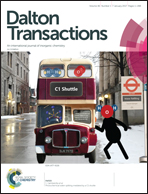A theoretical study on the unusual square-planar structure of bis(imino)pyridine-ligated Group 13 complexes†
Abstract
The unusual square-planar (SP) structure of four-coordinate AlIII-complexes with the phenyl-substituted tridentate bis(imino)pyridine (PhI2P) ligand has been studied by a combination of density functional theory (DFT) calculations, frontier molecule orbital (FMO), nucleus-independent chemical shift (NICS) and strain/interaction analyses. The calculations disclose that: (i) the aromaticity shifting from the pyridine ring to the alumina-imidazolate metallacycle, and (ii) the small strain energy imposed on the ligand backbone are two favourable factors for driving the overall SP coordination of the AlIII ion. Meanwhile, the calculations reveal that the SP coordination of the AlIII ion is also influenced by the fourth ligand that is bonded to the AlIII ion. The less steric demanding ligand could ensure the stronger aromaticity of the alumina-imidazolate metallacycle and small strain energy on the ligand backbone. Additionally, the calculations predict that GaIII and InIII ions favour the SP geometry in the analogue PhI2P-ligated complexes, while BIII and TlIII ions are reluctant to adopt the SP coordination with the PhI2P ligand. Overall, all of these findings would be helpful for the synthesis of more unknown low-valent main-group metal complexes bearing the bis(imino)pyridine ligand.


 Please wait while we load your content...
Please wait while we load your content...